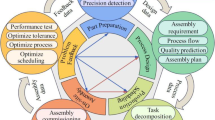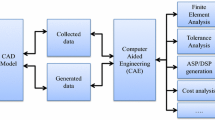Abstract
Virtual assembly (VA) is a key technology for virtual manufacturing systems. So far, CAD systems are still the main modeling tools for the VA system. There isn’t a standard data exchange criterion to transfer the data directly from CAD systems to VA applications, consequently an original data decomposition and information translation method (DDITM) was timely proposed to achieve the decomposition and translation. The information of the assembly bodies in the CAD system was divided into geometry information, topology information, and assembly information, etc., which were transferred to the VA application separately. The geometry information including the surface information was translated by the data translation interface (DTI) developed, the topology information was translated by a five-hierarchy topology structure (FHTS) constructed, and the assembly information was translated with database technology. A systematic architecture was formed with the interaction between the geometry information and the topology information, and the assembly information and the topology. Finally an experimental VA system was set up to verify the DDITM, and an assembly simulation was implemented to verify the assembly information further, which proves the translated information is precise and sufficient.
Similar content being viewed by others
References
Jayaram S, Connacher HI, Lyons KW (1997) Virtual assembly using virtual reality techniques. Comput Aided Des 29(8):575–584
Choi CK, Chan DSK, Yuen AMF (200") Application of virtual assembly tools for improving product design. Int J Adv Manuf Technol 19:377–383
Resseler S, Wang Q (1997) Using VRML to access manufacturing data. In: Proc VRML 1997: Second Symposium of the Virtual Modeling Language, Monterey, CA
Antonishek B, Egts DD, Obeysekare UR (1998) Virtual assembly using two-handed interaction techniques on the virtual workbench. Proc 1998 ASME Design Engineering Technical Conference, Atlanta, GA
Mock SM (2003) A Structural Product Coding System (SPCS) for Intelligent Product Data Management. PhD thesis of Northwestern University, Evanston, Illnois, USA
Lee JY (2001) Shape representation and interoperability for virtual prototyping in a distributed design environment. Int J Manuf Technol 17:425–434
Ikonomov PG, Kishinami T, Tanaka F (1996) Virtual assembly using STEP data. Proc Third ISPE International Conference on Concurrent Engineering, Toronto,
Huagen W, Shuming G, Qunsheng (1999) An integrated virtual design and virtual assembly environment. Proc CAD/Graphics99, Shanghai,
Angster SR (1996) VEDAM: virtual environment for design and manufacturing. Dissertation, Washington State University
Jayaram S, Jayaram U, Wang Y, Tirumali H (1999) VADE: a virtual assembly design environment. Comput Graph Appl 19(6):44–50
Weyrich M, Drews P (1999) An interactive environment for virtual manufacturing: the virtual workbench. Comput Ind 38:5–15
SolidWorks API manual (2001) web site at: http://www.solidworks.com/html/products/api/ last visited in May 2003
WorldToolKit Reference Manual (1999) Release 9, Sense8 Corporation, Mill Valley, CA
Roy U, Liu CR (1988) Establishment of functional relationships between product components in assembly database. Comput Aided Des 20(10):570–580
Steffan R, Schull U, Kuhlen T (1998) Integration of virtual reality based assembly simulation into CAD/CAM environments. Proceedings of 24th Annual Conference of IECON 98, Aachen Germany
Eng T-H, Ling Z-K, Olson W, McLean C (1999) Feature-based assembly modeling and sequence generation. Comput Ind Eng 36:17–33
Huagen W, Shuming G, Qunsheng P (2000) An approach to solid modeling in a semi-immersive virtual environment. Comput Graph 24:191–202
Author information
Authors and Affiliations
Corresponding author
Rights and permissions
About this article
Cite this article
Jiang-sheng, L., Ying-xue, Y., Pahlovy, S. et al. A novel data decomposition and information translation method from CAD system to virtual assembly application. Int J Adv Manuf Technol 28, 395–402 (2006). https://doi.org/10.1007/s00170-004-2284-3
Received:
Accepted:
Published:
Issue Date:
DOI: https://doi.org/10.1007/s00170-004-2284-3




